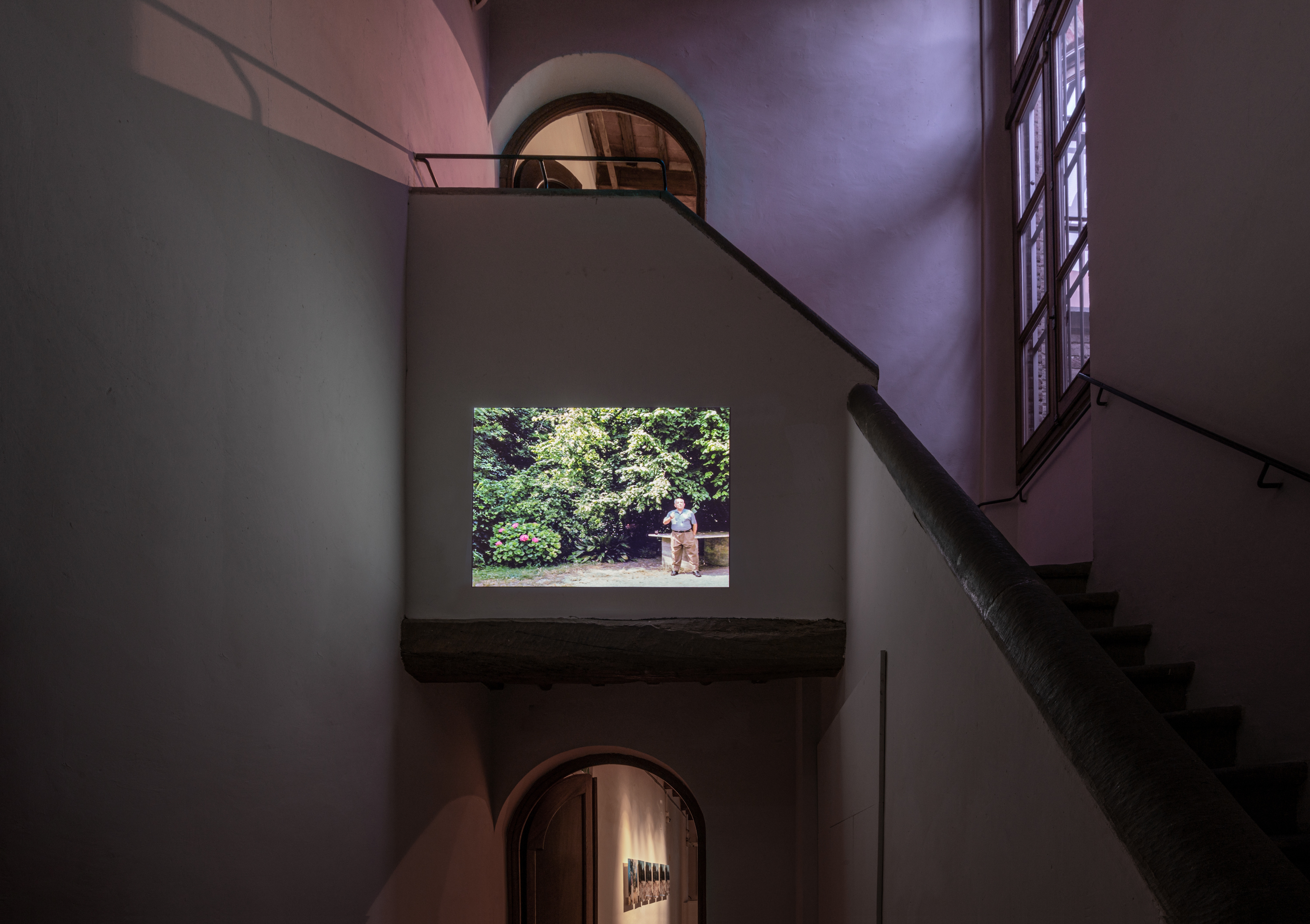ANTHOLOGY
CHAPTER I
The Green and the Stone
a cura di Rita Selvaggio
Inaugurazione: Sabato 4 giugno ore 18:00
The Remains of the Day (2014) · Shinzaggaran (2014) · Allotropes (2016) · Anime (2019) · Jean-Marie Straub e Danièle Huillet. Film e loro Siti (2020-2021) · While We Were Sleeping (2021) · The Green and the Stone. Straub-Huillet in Buti, un film di Armin Linke in collaborazione con Rinaldo Censi, Giulia Bruno and Giuseppe Ielasi (2017).

Jean-Marie Straub e Danièle Huillet. Film e loro siti. Installation view. Ph. Ela Bialkowska, OKNOStudio,
Courtesy Casa Masaccio | Centro per l’Arte Contemporanea.
Dal 4 giugno al 16 ottobre, Casa Masaccio | Centro per l’Arte Contemporanea ospita Anthology, primo capitolo di una sorta di catalogo messo in spazio che si lascia sfogliare pagina dopo pagina nelle stanze del museo e che raccoglie, attraverso film, documenti e documentari, testimonianze d’archivio, modelli, modi e tracce, alcuni episodi della storia recente della “casa”. Gesti e opere riconducono, molto spesso, a fossili di altri gesti e ad altre narrative fornendo, all’interno di questa iniziale selezione, connessioni e conversazioni.
Le premesse sono quelle di The Remains of the Day, inauguratasi nella notte di sabato 21 giugno 2014, giorno del solstizio d’estate, mostra in cui la pratica di una ventina di allora giovani artisti (Alessandro Agudio, Marco Basta, Lupo Borgonovo, Cleo Fariselli, Dario Guccio, Helena Hladilova, Invernomuto, Andrea Kvas, Alice Mandelli, Beatrice Marchi, Anna Mostosi, Gianni Politi, Lisa Rampilli, Giangiacomo Rossetti, Manuel Scano, Namsal Siedlecki, Davide Stucchi, Serena Vestrucci), si interrogava con approccio multidisciplinare su nuove possibili sintassi e sui depositi lasciati dal tempo rispetto ad un’azione performativa e /o di happening. I resti di quel lungo giorno si articolavano in un percorso che, dipanandosi in varie sedi, si poneva questioni che riguardano l’apparato espositivo e presentava opere frammentarie, partecipative o in progress. Vi era inclusa Shinzaggaran, dal nome di una sanguinosissima battaglia, avvenuta nel 1871, tra i Kel Denneg e i Kel Gers, tribù nomadi Tuareg per le quali il tempo dei miti non è quello dell’epica ma esiste solo nell’incessante fluidità del vissuto e nell’integrazione naturale del passato con il presente. La mostra, abitava completamente Casa Masaccio incoraggiando il visitatore a coreografare la propria stessa presenza. Tra gli interventi, tutti appositamente pensati per l’occasione, Concert for Caballeros (2014) di Beatrice Marchi, un concerto che, accogliendo cantori e cantastorie come anche una micia, trasformava la messa in scena in una sorta di fondale effimero. Suoni digitali che imitavano il clavicembalo, gli archi, il sitar e l’arpa al ritmo hip hop di un’atmosfera che richiamava a ballare le streghe e i fantasmi del borgo.
Hill of Dreams (2016), parte di Allotropes (2016), mostra personale di Jessica Warboys è un film che, commissionato da Casa Masaccio con Tate St.Ives (UK) e Kunsthall Stavanger (N), si ispira all’omonimo romanzo dello scrittore Arthur Machen (1863-1947) pubblicato nel 1907. In parte esplorazione mistica e commento su una società materialista, in parte autobiografia, racconta del viaggio di un’esteta e sognatore in un’altra realtà e in un mondo pagano per poi perdersi nella natura che circonda il piccolo villaggio di Caerleon nel Galles rurale. Il percorso espositivo, nonché narrativo, prosegue con il film documentario di While We Were Sleeping, la mostra personale di Lewis Hammond tenutasi nel 2021. Qui, l’intensità di un’intimità nascosta nelle infinite potenzialità della rappresentazione del reale e una narrazione crittografata sono ritmate da ampie campiture di verde che, pur nella sua artificialità, rimanda metaforicamente alle Storie della Genesi, ciclo di affreschi dipinti da Paolo Uccello per il chiostro di Santa Maria Novella a Firenze, prevalentemente eseguiti in un monocromo verdeterra, anzi -“a sugo d’erbe e terra verde”-, come scrisse a proposito il frate domenicano Vincenzo Borghigiani nel Settecento.
Il primo capitolo di quest’antologia, ospita inoltre un focus dedicato ai due registi Jean-Marie Straub e Danièle Huillet, recipienti della 13°|14° edizione del Premio Marco Melani e ospiti di Casa Masaccio con Film e loro siti, mostra alla quale sarà contestualmente dedicato il prossimo programma on-line di Esporre il cinema. Oltre all’introduzione di Enrico Ghezzi, direttore del premio e a materiali di repertorio, il focus ospita The Green and the Stone. Straub-Huillet in Buti (2017), un film di Armin Linke, in collaborazione con Rinaldo Censi, Giulia Bruno e Giuseppe Ielasi, girato nel Teatro Francesco di Bartolo di Buti, proprio nella campagna toscana, dove i due registi francesi avevano trovato ospitalità creativa. Il film è stato commissionato in occasione della mostra Tell It to the Stones. The Work of Danièle Huillet and Jean-Marie Straub (14.09.2017-19.11.2017) all’Akademie der Künste di Berlino e racconta della loro vocazione teatrale che presiede all’uso dei testi, del loro cinema orgogliosamente indipendente e privo di orpelli spettacolari, come delle loro inquadrature che si concedono panoramiche dentro la natura, verso un punto di luce che è promessa e destino.
Questo primo capitolo di Anthology si chiude con Disarmo (2019) di Giulia Piscitelli. Commissionato in occasione di Anime, sua mostra personale del medesimo anno, si rivela oggi più che mai, un monito tanto profetico quanto attuale. In esso, in una ripresa video unica che non tollera sovrapposizioni, le mani forti di Yuriy Onishchuk, ucraino di Zmerinka, distruggono un’arma con il flex annientandola e riducendola in polvere inoffensiva.

